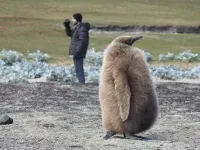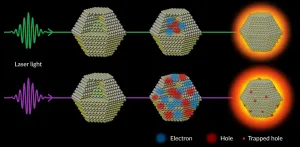New study published in Science maps wildlife microbiota
Discovering millions of previously unknown potential human therapeutics
2021-03-25
(Press-News.org) Tel-Aviv, ISRAEL - March 25, 2021 - Wild Biotech, a preclinical stage drug discovery & development company emerging out of stealth mode, today announces the publication of its first major paper, which appears in the journal Science. The study mapped the gut microbiota of animals in the wild on an unprecedented scale, adding millions of potentially novel microbiome-based therapeutics for human diseases to the company's already massive database. Wild will use these findings to first tap its database for targets in inflammatory, immune and gastrointestinal diseases.
"For the study, we collected gut microbiota from almost 200 species of animals in the wild, covering diverse classes, feeding behaviors, geographies, and traits," said Neta Raab, Co-founder & Chief Executive Officer at Wild Biotech. "Using de novo metagenome assembly, we constructed and functionally annotated a database of over 5,000 microbial genomes from those animals covering more than 1,200 bacterial species - 75% of which were previously unknown."
Animals in the wild exhibit extraordinary feats of survival. Some, from hyenas and jackals to Tasmanian devils, subsist on rotting, pathogen-infected and toxic food while remaining immune to disease - possible due, in part, to their gut microbiota. While the understanding of the diversity and functions within these ecosystems is poor, the microbial composition, diversity, and functional content of animals' microbiota have known associations with animal taxonomy, diet, activity, social structure and lifespan. "These are clues which we could tap into in order to discover entirely new agents to treat human diseases," Raab said.
The findings reported in Science add 30 million genes - each representing a potentially new therapeutic agent - to Wild's unique database of animal microbiota, which now comprises hundreds of animal species and 100 million genes. "The majority of that genomic material is novel, and our database introduces thousands of previously undescribed species into the bacterial tree of life," Raab said.
Wild applies cutting-edge AI tools to decipher the therapeutic potential of its database and identify proteins, peptides, bacteriophages, and other agents with direct activity on targets in human diseases. The company's database is unique because, unlike microbes found in the ocean or soil, the gut microbiota of animals is the most relevant and directly translatable to human therapeutics.
Wild Biotech's database and AI tools are complemented by high-throughput synthetic biology to validate microbiome-derived agents and accelerate them into preclinical testing, and the high quality of the data extracted from microbial genomes enables the company to directly synthesize and test agents. For example, in the Science study the team synthesized a panel of previously-undescribed enzymes from carrion eater microbiota and showed that they operate on a range of microbial toxins, suggesting a mechanism that detoxifies carrion for its safe consumption by the host animal.
The company has also identified in its database over 2,000 CRISPR/Cas genome editing systems, of which approximately one third does not belong to any known CRISPR/Cas family.
"Intractable diseases require new thinking on intervention. Wild has built a revolutionary approach and the tools to explore its novel data sets, unlike any other company," said Dr. John Baldoni, leading pharmaceutical industry expert and advisor to Wild. "You must have the data in order to do the computational work. Because of their highly evolved and relevant library, they are able to look at millions of interactions quickly, within days, and screen and target logical therapeutic areas. Wild's approach enables a translatable workflow from its microbiome data to molecular mechanisms associated with complex diseases."
"We are balancing innovation and clinical evidence to screen many millions of interactions with specific targets associated with human diseases," said Raab. "We are very excited about the extraordinary potential hidden in this database for identifying entirely novel approaches to treat disease."
INFORMATION:
Science paper: https://science.sciencemag.org/content/early/2021/03/24/science.abb5352
About Wild Biotech
Wild Biotech is a preclinical stage drug discovery & development company pioneering the new emerging fields of synthetic metagenomics and microbiome-derived therapeutics. The woman-led company integrates state-of-the-art bioinformatics with high-throughput synthetic capabilities to discover therapeutic leads and accelerate them into clinical development. The company is backed by private investor Marius Nacht and venture capital fund TechBio.
[Attachments] See images for this press release:

ELSE PRESS RELEASES FROM THIS DATE:
2021-03-25
Water scarcity in rural Alaska is not a new problem, but the situation is getting worse with climate change. Lasting solutions must encourage the use of alternative water supplies like rainwater catchment and grey water recycling. They must also address the affordability of water related to household income, say researchers from McGill University.
Washing hands with clean water is something most people take for granted, yet for Alaska's rural residents, this is often not the case. When people pay for water by the gallon, serious thought is given to how much is used - even during the COVID-19 pandemic.
In many rural Alaskan communities, where jobs are scarce and household income is low, the cost of water is a high burden, according to the study published in Environmental ...
2021-03-25
A medical device that has been shown to manage pain among babies born preterm can also help keep their brain oxygen levels steady during medical procedures, finds new analysis by researchers at UBC.
The device, called Calmer, is a pillow-sized therapeutic bed covered in soft fabric and inserted into the incubator. It can be programmed to mimic a parent's heartbeat and breathing rate-- providing a soothing presence by moving up and down gently to simulate a breathing motion and heartbeat sound for the baby when their parent cannot be present.
"For newborns and particularly for preterm babies, it's critical to keep overall blood oxygen levels steady, especially in the brain. The more stable their brain oxygenation is, the better for their brain development," ...
2021-03-25
Researchers at the Georgia Institute of Technology have uncovered an innovative way to tap into the over-capacity of 5G networks, turning them into "a wireless power grid" for powering Internet of Things (IoT) devices that today need batteries to operate.
The Georgia Tech inventors have developed a flexible Rotman lens-based rectifying antenna (rectenna) system capable, for the first time, of millimeter-wave harvesting in the 28-GHz band. (The Rotman lens is key for beamforming networks and is frequently used in radar surveillance systems to see targets in multiple directions without physically moving the antenna system.)
But to harvest enough power to supply low-power devices at long ranges, large aperture antennas are required. The problem with ...
2021-03-25
Researchers at Baylor College of Medicine, Shandong University in China and other institutions may have found an explanation for dawn phenomenon, an abnormal increase of blood sugar only in the morning, observed in many patients with type 2 diabetes. They report in the journal Nature that mice lacking the circadian clock gene called Rev-erb in the brain show characteristics similar to those of dawn phenomenon.
The researchers then looked at Rev-erb gene expression in patients with type 2 diabetes comparing a group with dawn phenomenon to a group without it and found that the gene's expression followed a different temporal pattern between these two groups. The findings support the idea that an altered daily rhythm of expression of the Rev-erb gene may underlie dawn phenomenon. Future ...
2021-03-25
WASHINGTON (March 25, 2021)--Although demand for COVID-19 vaccines currently seems high, vaccine hesitancy could pose a major threat to public health efforts to end the pandemic, according to an editorial published today in the journal Science.
The authors, including David A. Broniatowski, associate director of the George Washington University Institute for Data, Democracy & Politics, point out that public sentiment towards vaccines are volatile in the face of events such as the recent controversy surrounding the AstraZeneca vaccine clinical trial data. For example, some people could develop safety concerns due to the news reporting about the AstraZeneca vaccine and then turn down the chance to ...
2021-03-25
Narcissism is driven by insecurity, and not an inflated sense of self, finds a new study by a team of psychology researchers. Its research, which offers a more detailed understanding of this long-examined phenomenon, may also explain what motivates the self-focused nature of social media activity.
"For a long time, it was unclear why narcissists engage in unpleasant behaviors, such as self-congratulation, as it actually makes others think less of them," explains Pascal Wallisch, a clinical associate professor in New York University's Department of Psychology and the senior author of the paper, which appears in the journal Personality and Individual Differences. "This has become quite prevalent in the age of social media--a behavior that's been coined 'flexing'.
"Our ...
2021-03-25
A study by prof. Bas van Bavel and prof. Marten Scheffer shows that throughout history, most disasters and pandemics have boosted inequality instead of levelling it. Whether such disastrous events function as levellers or not, depends on the distribution of economic wealth and political leverage within a society at the moment of crisis. Their findings on the historical effects of crises on equality in societies are now published open access in Nature HSS Communications.
It is often thought that the main levellers of inequality in societies were natural disasters such as epidemics or earthquakes, and social turmoil such as wars and ...
2021-03-25
CHAMPAIGN, Ill. -- Materials that contain special polymer molecules may someday be able to warn us when they are about to fail, researchers said. Engineers at the University of Illinois Urbana-Champaign have improved their previously developed force-sensitive molecules, called mechanophores, to produce reversible, rapid and vibrant color change when a force is applied.
The new study led by postdoctoral researcher Hai Qian, materials science and engineering professor and head Nancy Sottos, and Beckman Institute of Advanced Science and Technology director Jeffrey Moore is published in the journal Chem.
Moore's team has been working with mechanophores for more than a decade, but past efforts have produced molecules that were slow to react and return to their original state, if at all. ...
2021-03-25
Bright semiconductor nanocrystals known as quantum dots give QLED TV screens their vibrant colors. But attempts to increase the intensity of that light generate heat instead, reducing the dots' light-producing efficiency.
A new study explains why, and the results have broad implications for developing future quantum and photonics technologies where light replaces electrons in computers and fluids in refrigerators, for example.
In a QLED TV screen, dots absorb blue light and turn it into green or red. At the low energies where TV screens operate, this conversion of light from one color to another is virtually 100% efficient. But at the higher excitation energies required for brighter screens and other ...
2021-03-25
In the year since the coronavirus pandemic upended how just about every person on the planet interacts with one another, video conferencing has become the de facto tool for group collaboration within many organizations. The prevalent assumption is that technology that helps to mimic face-to-face interactions via a video camera will be most effective in achieving the same results, yet there's little data to actually back up this presumption. Now, a new study challenges this assumption and suggests that non-visual communication methods that better synchronize and boost audio cues are in fact more effective.
Synchrony Promotes Collective Intelligence
Researchers from Carnegie Mellon's Tepper School of Business and the Department of Communication at the University of California, Santa ...
LAST 30 PRESS RELEASES:
[Press-News.org] New study published in Science maps wildlife microbiota
Discovering millions of previously unknown potential human therapeutics



